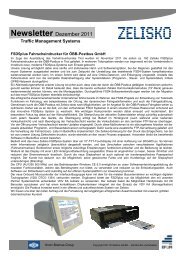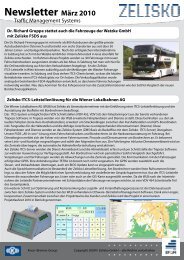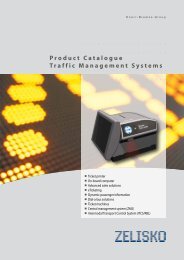Annual Report 2012 - Knorr-Bremse AG.
Annual Report 2012 - Knorr-Bremse AG.
Annual Report 2012 - Knorr-Bremse AG.
Create successful ePaper yourself
Turn your PDF publications into a flip-book with our unique Google optimized e-Paper software.
<strong>Report</strong><br />
113<br />
The modern HVAC systems feature two separate cooling circuits filled with R-134a refrigerant. The<br />
units have a maximum cooling output of 35 kW, and a maximum heating output of 32 kW. During<br />
operation a sensor constantly monitors the CO 2<br />
content of the air in the respective compartment. The<br />
higher this rises, the more fresh air the system draws in from the outside.<br />
<strong>Knorr</strong>-<strong>Bremse</strong> receives follow-up order for Velaro RUS 2<br />
Sapsan – meaning peregrine falcon – is the name given to the Velaro RUS high-speed train manufactured<br />
by Siemens. Russian state railway operators RZD use their eight Sapsans on the busy<br />
line between Moscow and St. Petersburg, amongst other routes. Despite making a number of<br />
halts, the high-speed trains cover the 650-odd kilometers in a mere 3 hours and 45 minutes. And<br />
even in challenging weather conditions the Sapsan achieves reliability levels of between 95% and<br />
98% – thanks partly to the braking, HVAC and door systems developed and supplied by <strong>Knorr</strong>-<br />
<strong>Bremse</strong>.<br />
The Sapsan is to<br />
continue to rely<br />
on <strong>Knorr</strong>-<strong>Bremse</strong><br />
systems for its<br />
journeys from<br />
Moscow to<br />
St. Petersburg.<br />
RZD recently ordered eight more high-speed trains, and <strong>Knorr</strong>-<strong>Bremse</strong> will also be supplying the<br />
braking, HVAC and door systems for these new Velaro RUS 2 vehicles. They will be used to increase<br />
the frequency of the service on the busy route between Moscow and St. Petersburg and also on the<br />
line between Moscow and Nizhny Novgorod.<br />
As the power supply on the lines to St. Petersburg and Nizhny Novgorod use different systems, and<br />
RZD wishes to be able to use the trains flexibly on either route, the Velaro RUS 2 had to be capable<br />
of operating in double traction. This meant <strong>Knorr</strong>-<strong>Bremse</strong> had to design completely new software<br />
architecture for the brake control system. During the year under review the first of the new braking<br />
systems were delivered to Siemens.<br />
Moscow Metro opts once again for <strong>Knorr</strong>-<strong>Bremse</strong><br />
More than 9 million passengers used the metro system in Moscow at peak periods, and train frequency<br />
is therefore very high. From the point of view of the operator, the vehicles therefore have to be<br />
completely reliable. But there is a further factor – some of the metro runs overground, and the trains<br />
and their systems therefore also have to operate at extremely low temperatures.<br />
<strong>Knorr</strong>-<strong>Bremse</strong>’s extensive experience of the Russian market means the company can meet both these<br />
requirements – which was one of the reasons it was chosen last year to supply various systems for the<br />
360 new-generation cars ordered by Moscow Metro from Russian vehicle builders Metrowagonmash<br />
and OAO TVZ. <strong>Knorr</strong>-<strong>Bremse</strong> will be delivering oil-free compressors and block brake units. But the<br />
company’s involvement does not stop there – the door systems will be coming from IFE, and Italian<br />
subsidiary Microelettrica Scientifica will for the first time be supplying resistors and circuit breakers.<br />
This has enabled <strong>Knorr</strong>-<strong>Bremse</strong> to successfully expand its share of the systems supplied to the metro.<br />
Crucial factors in winning this order were the high levels of service competence demonstrated<br />
by <strong>Knorr</strong>-<strong>Bremse</strong>’s local staff and the company’s plan to produce the braking systems directly in Russia.<br />
NYAB strengthens market position in driver assistant systems<br />
In fiscal <strong>2012</strong>, <strong>Knorr</strong>-<strong>Bremse</strong>’s US subsidiary New York Air Brake (NYAB) continued to expand the installed<br />
fleet for its LEADER driver assistant system. By year’s end NYAB had delivered more than 2,500<br />
systems to eight customers worldwide.<br />
LEADER is a sophisticated train management system that significantly improves the locomotive<br />
engineer’s ability to handle heavy freight trains more economically and safely than ever before.



![1 Newsletter 2013 Version 0 92 [Kompatibilitätsmodus] - Zelisko](https://img.yumpu.com/50939577/1/184x260/1-newsletter-2013-version-0-92-kompatibilitaatsmodus-zelisko.jpg?quality=85)




![Backofficelösung ZMS [PDF, 740 kB] - Zelisko](https://img.yumpu.com/33964695/1/184x260/backofficelaasung-zms-pdf-740-kb-zelisko.jpg?quality=85)

![Geschäftsbericht 2012 [PDF, 13 MB] - Zelisko](https://img.yumpu.com/31517535/1/184x260/geschaaftsbericht-2012-pdf-13-mb-zelisko.jpg?quality=85)


![Produktkatalog Gesamtlösungen [PDF, 4 MB] - Zelisko](https://img.yumpu.com/22973479/1/182x260/produktkatalog-gesamtlaasungen-pdf-4-mb-zelisko.jpg?quality=85)
![ITCS Datenblatt [PDF, 804 kB] - Zelisko](https://img.yumpu.com/22855155/1/184x260/itcs-datenblatt-pdf-804-kb-zelisko.jpg?quality=85)
![Fahrscheindrucker FSD5plus [PDF, 934 kB] - Zelisko](https://img.yumpu.com/22822643/1/184x260/fahrscheindrucker-fsd5plus-pdf-934-kb-zelisko.jpg?quality=85)
